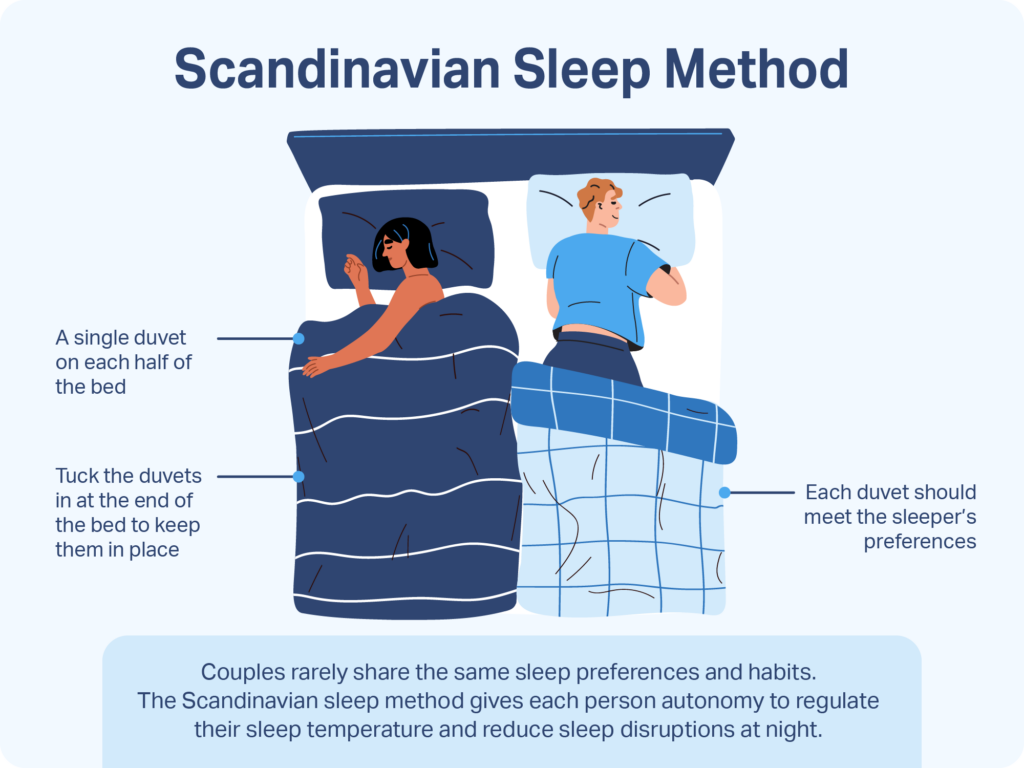What Is the Scandinavian Sleep Method?
- In the Scandinavian sleep method, couples use two separate duvets to lessen sleep disruption.
- Partners can still share a bed but have individual single-size comforters or duvets.
- Each partner can personalize their sleep to fit their individual preferences and minimize disturbing one another.
- Two covers are more economical than two beds, while still allowing for a close, co-sleeping experience.
If you share a bed with a partner, you may be interested in trying the Scandinavian sleep method, which involves using two separate duvets in order to give each person more freedom as they sleep. The method gets its name from this popular sleeping style in the Scandinavian countries of Sweden, Norway, and Denmark. Couples may prefer the Scandinavian sleep method because it allows the benefits of co-sleeping while also allowing each person autonomy to use their own bedding.
The vast majority of U.S. couples sleep together in the same bed. Sharing a bed can be far from ideal if it means fighting over the blankets or enduring someone’s tossing and turning. For couples looking for alternatives to a full-on sleep divorce, we discuss the benefits and drawbacks of the Scandinavian sleep method and how to try it at home.
Is Your Troubled Sleep a Health Risk?
A variety of issues can cause problems sleeping. Answer three questions to understand if it’s a concern you should worry about.
How Does the Scandinavian Sleep Method Work?
In October 2023, millions of TikTok users learned about the Scandinavian sleep method thanks to a viral post from Swedish influencer Cecilia Blomdahl. With this method, partners share a bed but ditch the top cover and sleep under their own single-size duvet or comforter instead of sharing a larger one. This practice can minimize sleep-related disruptions and allows each person to regulate their own temperature at night.
Although comforters or blankets could also be used, duvets are traditionally used for the Scandinavian sleep method because they were developed in Scandinavia and other colder European countries.
What Are the Benefits of the Scandinavian Sleep Method?
The Scandinavian sleep method has many benefits for a person’s sleep environment, allowing complete autonomy over their bedding, even when co-sleeping. This customization of bedding can maximize an ideal sleeping environment.

Sleepers Can Regulate Their Body Temperature
During sleep, temperature needs can vary, but often not in sync with your bed partner. When sleepers are unable to regulate temperature, insomnia worsens and sleep quality suffers. Individual bedding allows people to adjust their body temperature exactly as they need without having to impact or negotiate with their sleep partner.
Using two duvets allows each person freedom over their temperature while sleeping. Someone who is colder can fully wrap themselves in their duvet. Someone who sleeps hotter has the ability to sleep with a lighter blanket or drape their duvet over part of their body, exposing their legs or feet on either side for airflow. Two duvets also solve blanket hogging so that each person can sleep according to their own preferences without disruption.
Partners Can Personalize Their Sleep Experience
If one person runs hot and the other tends to run cold, each person can seek out bedding that suits them instead of compromising on a middle option that may be uncomfortable for both. Hot sleepers may prefer thinner duvets with less fill or a thin blanket while cold sleepers may prefer a thick, heavy duvet.
It Minimizes Partner Disruptions
People who sleep with a restless partner tend to wake up more often during the night . With the Scandinavian sleep method, there is less disturbance with tossing and turning or nighttime bathroom trips from their bed partners.
Having a different sleep schedule than your partner can also impact your sleep if they are getting into bed after you and accidentally waking you up. Individual duvets are a great option for people who go to bed late or wake up early and want to avoid disturbing their sleep partner. The Scandinavian sleep method makes it easier for one person to crawl into bed while the other person is asleep, allowing each person to choose the bedtime that works best for them.

Couples Can Maintain the Benefits of Co-Sleeping
Many couples see sharing a bed as a key part of their relationship . The Scandinavian sleep method allows couples to continue sleeping in the same bed without sacrificing their sleep quality.
Sleeping with a partner may reduce stress levels and promote better sleep by helping a person feel more calm, secure, and comfortable . Research suggests that co-sleeping may also increase time spent in rapid eye movement (REM) sleep, which is important for mental health as well as processing memories and developing social skills.
Bed sharing is thought to have stronger effects than simply sharing a room with two separate beds. Bed sharing with a loved one can release oxytocin, which is linked to improved emotional regulation, lower stress levels, and better well-being. In studies of happy couples, participants say that they value sleeping within easy reach of their partner and that sleeping together is comforting.
Two Duvets Are Less Costly Than Two Beds
The Scandinavian sleep method is a good option for couples who want to try a different co-sleeping method and avoid spending money on two mattresses and two sheet sets. Sleeping on a single mattress is also more practical for couples who have bedroom space constraints and cannot have two beds.
What Are the Cons of Separate Duvets?
Not all couples’ sleep troubles can be solved by using two separate duvets. Other logistical issues may also make the Scandinavian sleep method undesirable for some people.
Difficult to Cuddle
Sleeping under two separate duvets may limit couple-friendly sleep positions such as spooning and may make nighttime cuddling more difficult since two people cannot fit under the smaller duvets. Couples using the Scandinavian sleep method can cuddle before bedtime and then move under their individual bedding for sleep.
May Not Fit a Smaller Bed
Since duvets and comforters are designed to hang a little over the edges of the bed, two duvets may not fit easily on the bed. To fix this, you can have the two duvets overlap a little in the middle of the bed, buy smaller separate duvets or it may make sense to invest in a larger bed, especially if you are someone who easily wakes up from their partner’s movements.
Harder to Make the Bed
The bed may not look as neat with two single duvets on top as it does with one larger duvet. One option is to use two matching duvets. Another option is to lay an extra blanket or quilt over top of the bed to hide the two duvets. Alternatively, folding each duvet in half lengthwise can make for a neater appearance during the day, especially on smaller beds.
The Scandinavian Sleep Method Cannot Fix All Problems
While the Scandinavian sleep method can mitigate some problems of co-sleeping with a partner, movements from one sleeper can still travel across the mattress to affect the other sleeper.
If one partner has a sleep disorder such as restless legs syndrome or periodic limb movements that causes more intense movements, then couples may need to invest in a motion-absorbing memory foam mattress or sleep in separate beds. Likewise, the Scandinavian sleep method does not eliminate disruptions from sleep talking or snoring since couples are still in close proximity.
How to Make Your Bed Scandinavian Style
When preparing to switch to the Scandinavian sleep method, couples must decide what type of bedding they want.
- Find two duvets: Each duvet should cover approximately half of the bed. Most couples choose two twin size duvets or two twin XL duvets. Each duvet can be personalized to the preferences of each sleeper. For example, one person may want a heavy comforter while the other may prefer a light, breathable blanket.
- Decide whether to use a top sheet: A top sheet is an extra layer under your duvet. Some sleepers, especially if they tend to get hot at night, may prefer not to use a top sheet. Typically, the Scandinavian sleep method does not involve a top sheet.
- Layer duvets on the bed: Lay each duvet on either side of the bed where each person sleeps. The duvets may overlap a little in the middle of the bed so that they do not hang off the edges. To ensure the duvets stay in place throughout the night, you can choose to tuck them in at the foot of the bed.
- Finish with a decorative throw: Those who prefer not to see the dividing line or mismatched duvets may wish to add a decorative throw or quilt on top.

Still have questions? Ask our community!
Join our Sleep Care Community — a trusted hub of sleep health professionals, product specialists, and people just like you. Whether you need expert sleep advice for your insomnia or you’re searching for the perfect mattress, we’ve got you covered. Get personalized guidance from the experts who know sleep best.
References
4 Sources
-
Harding, E. C., Franks, N. P., & Wisden, W. (2019). The temperature dependence of sleep. Frontiers in Neuroscience, 13, 336.
https://pubmed.ncbi.nlm.nih.gov/31105512/ -
Walters, E. M., Phillips, A. J. K., Mellor, A., Hamill, K., Jenkins, M. M., Norton, P. J., Baucom, D. H., & Drummond, S. P. A. (2020). Sleep and wake are shared and transmitted between individuals with insomnia and their bed-sharing partners. Sleep, 43(1), zsz206.
https://pubmed.ncbi.nlm.nih.gov/31553049/ -
Rahn, A., Bennett, C., Jones, T., & Lykins, A. (2020). Happily partnered older adults’ relationship-enhancing behaviours. Australasian Journal on Ageing, 39 Suppl 1, 30–39.
https://pubmed.ncbi.nlm.nih.gov/32567185/ -
Andre, C. J., Lovallo, V., & Spencer, R. M. C. (2021). The effects of bed sharing on sleep: From partners to pets. Sleep Health, 7(3), 314–323.
https://pubmed.ncbi.nlm.nih.gov/33436343/


















































